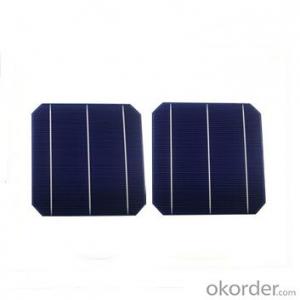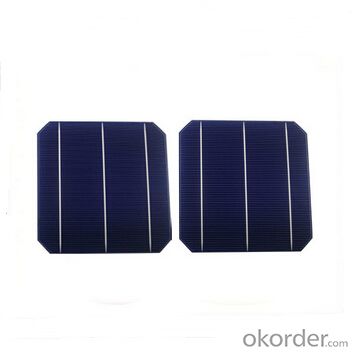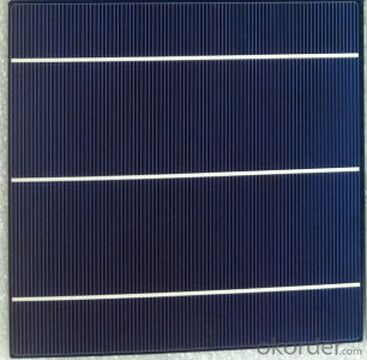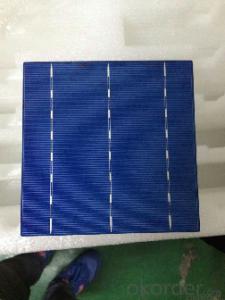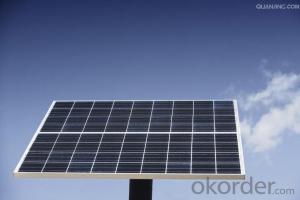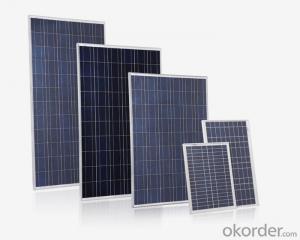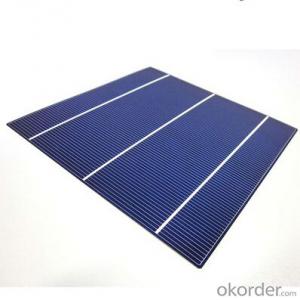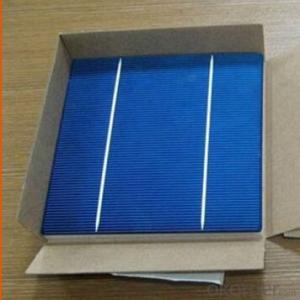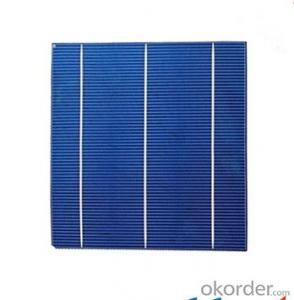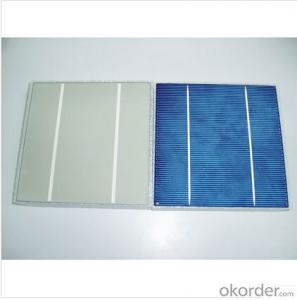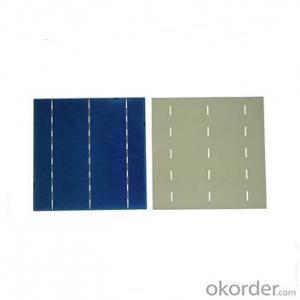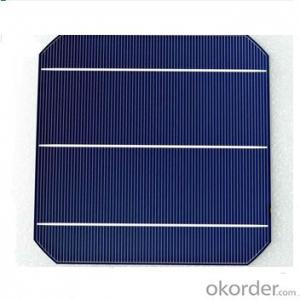Buy Loose Polycrystalline Solar Cells - High Quality 17.80%-17.99% Efficiency
- Loading Port:
- Shanghai
- Payment Terms:
- TT OR LC
- Min Order Qty:
- 1000 pc
- Supply Capability:
- 1000000 pc/month
OKorder Service Pledge
OKorder Financial Service
You Might Also Like
Solar Cells:
solar cells, when struck by photons of light from the sun, generates an electrical current which can then be used to power DC or AC electrical loads.
A solar cell is made of silicon. Computer chips are made of this same material. Basically, when light strikes the surface of a solar cell some of it is absorbed into the silicon. This light energy bumps the electrons loose and causes energy to flow
Solar cells is made by solar wafer, it has three categories of solar cell right now, monocrystalline polycrystalline and thin film,These cells are entirely based around the concept of PN junction, which is the critical part of solar module, it is the part that can convert the light energy into electricity, the thickness is from 180um to 200um, with even busbars to conduct electricity, textured cell can decrease diffuse reflection; they are often electrically connected and encapsulated as a module. Photovoltaic modules often have a sheet of glass on the front (sun up) side, allowing light to pass while protecting semiconductor wafers from abrasion and impact due to wind-driven debris, rain, hail, etc. Solar cells are also usually connected in series in modules, creating an additive voltage. Connecting cells in parallel will yield a higher current;With high quality and stable quality. Our Cells can greatly improve the performance of Solar Modules.
Specifications
Model | Efficiency | Power | Max Power Current | Min Power Current | Max Power Voltage | Short Circuit Current | Open Circuit Voltage |
Eff(%) | Ppm(W) | Ipm(A) | Ipm(A) | Vpm(V) | Isc(A) | Voc(V) | |
GS-156P | 17.80-17.99 | 3.89 | 7.50 | 7.38 | 0.527 | 8.04 | 0.630 |
GS-156P | 17.60-17.79 | 3.84 | 7.45 | 7.32 | 0.525 | 7.94 | 0.628 |
GS-156P | 17.40-17.59 | 3.80 | 7.40 | 7.25 | 0.523 | 7.90 | 0.629 |
GS-156P | 17.20-17.39 | 3.76 | 7.35 | 7.17 | 0.518 | 7.86 | 0.628 |
GS-156P | 17.00-17.19 | 3.71 | 7.3 | 7.10 | 0.516 | 7.80 | 0.625 |
Solar Cells Advantage:
• High efficiency and stable performance in photovoltaic conversion.
• Advanced diffusion technique ensuring the homogeneity of energy conversion efficiency of the cell.
• Advanced PECVD film forming, providing a dark blue silicon nitride anti-reflection film of homogenous color and attractive appearance.
• High quality metal paste for back surface and electrode, ensuring good conductivity, high pulling strength and ease of soldering.
• High precision patterning using screen printing, ensuring accurate busbar location for ease with automatic soldering a laser cutting.
Features:
High efficiencies up to 16.4%
Proven long term mechanical stability of silicone
Make of highly purified poly silicone
Three bus bars for reduced series resistance and improved module and cell efficiency
Blue anti-reflecting coating ensures improved light absorption and increased efficiency
Acid texturization offers a uniform appearance and virtually invisible crystal structure
Excellent low light behavior for improved energy yield
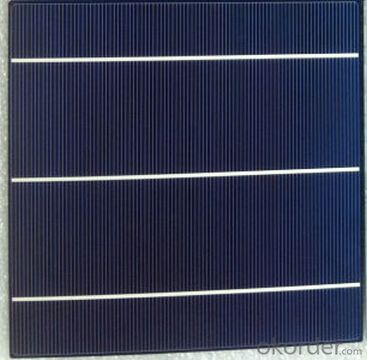
FAQ
We have organized several common questions for our clients,may help you sincerely:
①What price for each watt?
It depends on the efficiency of the solar cell, quantity, delivery date and payment terms.
②How long can we receive the product after purchase?
In the purchase of product within three working days, We will arrange the factory delivery as soon as possible. The pecific time of receiving is related to the state and position of customers.Commonly 7 to 10 working days can be served.
③Can you provide the peripheral products of the solar panels, such as the battery, controller, and inverter? If so, can you tell me how do they match each other?
Yes, we can, we have two companies for solar region, one is CNBM International, the other is CNBM engineering Co.
We can provide you not only the solar module but also the off grid solar system, we can also provide you service with on grid plant.
④What is your warranty of solar cell?
Our product can promise lower than 0.3% open box crack, we support claim after opening the box if it has crackm color difference or sth, the buyer should give pictures immediately, we can not accept the claim after the solar cell has assembled to solar panel.
• Timeliness of delivery
• ⑤How do you pack your products?
We have rich experience on how to pack the solar cell to make sure the safety on shipment, we could use wooden box or pallet as buyer's preference.
- Q: Are solar cells affected by temperature?
- Yes, solar cells are indeed affected by temperature. High temperatures can cause a decrease in the efficiency of solar cells, resulting in reduced power output. Conversely, low temperatures can sometimes lead to a slight increase in efficiency.
- Q: How do solar cells perform in areas with high levels of air pollutants?
- Solar cells may experience a decrease in performance in areas with high levels of air pollutants due to reduced sunlight reaching the surface. The presence of pollutants such as smog and particulate matter can block and scatter sunlight, thereby reducing the efficiency of solar cells. Regular cleaning and maintenance of solar panels can help mitigate the impact of air pollutants and ensure optimal performance.
- Q: Can solar cells be used to charge batteries?
- Yes, solar cells can be used to charge batteries. Solar cells convert sunlight into electrical energy, which can be harnessed to charge batteries by connecting them to a solar panel. The solar panel absorbs sunlight, converts it into electricity, and then transfers that energy to charge the batteries.
- Q: Can solar cells be used to power an entire household?
- Yes, solar cells can be used to power an entire household. With advancements in solar technology and proper installation, a solar power system can generate enough electricity to meet the energy needs of a household, especially when combined with energy storage solutions. However, the feasibility and effectiveness of using solar cells to power an entire household depend on various factors such as the size of the solar system, energy consumption patterns, geographic location, and available sunlight.
- Q: How do solar cells affect the electricity grid?
- Solar cells can have both positive and negative impacts on the electricity grid. On one hand, they can contribute to a more sustainable and renewable energy mix by generating clean electricity directly from sunlight. This reduces the need for fossil fuel-based power generation, leading to a decrease in greenhouse gas emissions and air pollution. Solar cells can also help diversify the energy sources in the grid, making it more resilient and less dependent on imported energy. On the other hand, the intermittent nature of solar power can pose challenges to the stability and reliability of the electricity grid. Since solar cells only generate electricity when the sun is shining, their output fluctuates throughout the day and is absent during nighttime. This can create imbalances between electricity supply and demand, as the grid needs to ensure a constant and reliable power supply to consumers. Additional measures, such as energy storage systems or backup power sources, may be required to address these intermittency issues and maintain grid stability. Overall, the integration of solar cells into the electricity grid presents opportunities for cleaner energy generation and reduced reliance on fossil fuels, but it also necessitates careful planning and the implementation of appropriate grid management strategies to mitigate potential challenges.
- Q: How do solar cells perform in areas with high levels of noise pollution?
- Solar cells are not affected by noise pollution as it has no impact on their performance. Noise pollution does not interfere with the ability of solar cells to convert sunlight into electricity, making them a reliable energy source even in areas with high levels of noise pollution.
- Q: Can solar cells be used for outdoor signage?
- Yes, solar cells can be used for outdoor signage. They are an environmentally friendly and sustainable option that can provide power to illuminate and operate outdoor signs. Solar cells can capture sunlight and convert it into electricity, making them an ideal choice for outdoor signage that is located in areas with ample sunshine.
- Q: What's the relationship between solar energy materials and solar cells?
- The solar cells can be divided into different categories based on the different kinds of solar materials which are used to produce the solar cells.
- Q: Can solar cells be used in indoor applications?
- Yes, solar cells can be used in indoor applications, although their efficiency may be lower compared to outdoor use. Indoor applications typically include powering small electronic devices or providing lighting for indoor spaces.
- Q: I am a purchasing manager for a EPC engineering company, and we are planning to purchasing some 4bb solar cells for one of our project in Taiwan, can I get a quotation online?
- We are a professional company selling solar cells. Tomi Fuji is dedicated to provide high quality solar products, ranging from Photovoltaic (PV) cells, PV modules to PV power systems. You can trust us to get the best quality product with the best price.
Send your message to us
Buy Loose Polycrystalline Solar Cells - High Quality 17.80%-17.99% Efficiency
- Loading Port:
- Shanghai
- Payment Terms:
- TT OR LC
- Min Order Qty:
- 1000 pc
- Supply Capability:
- 1000000 pc/month
OKorder Service Pledge
OKorder Financial Service
Similar products
Hot products
Hot Searches
Related keywords
